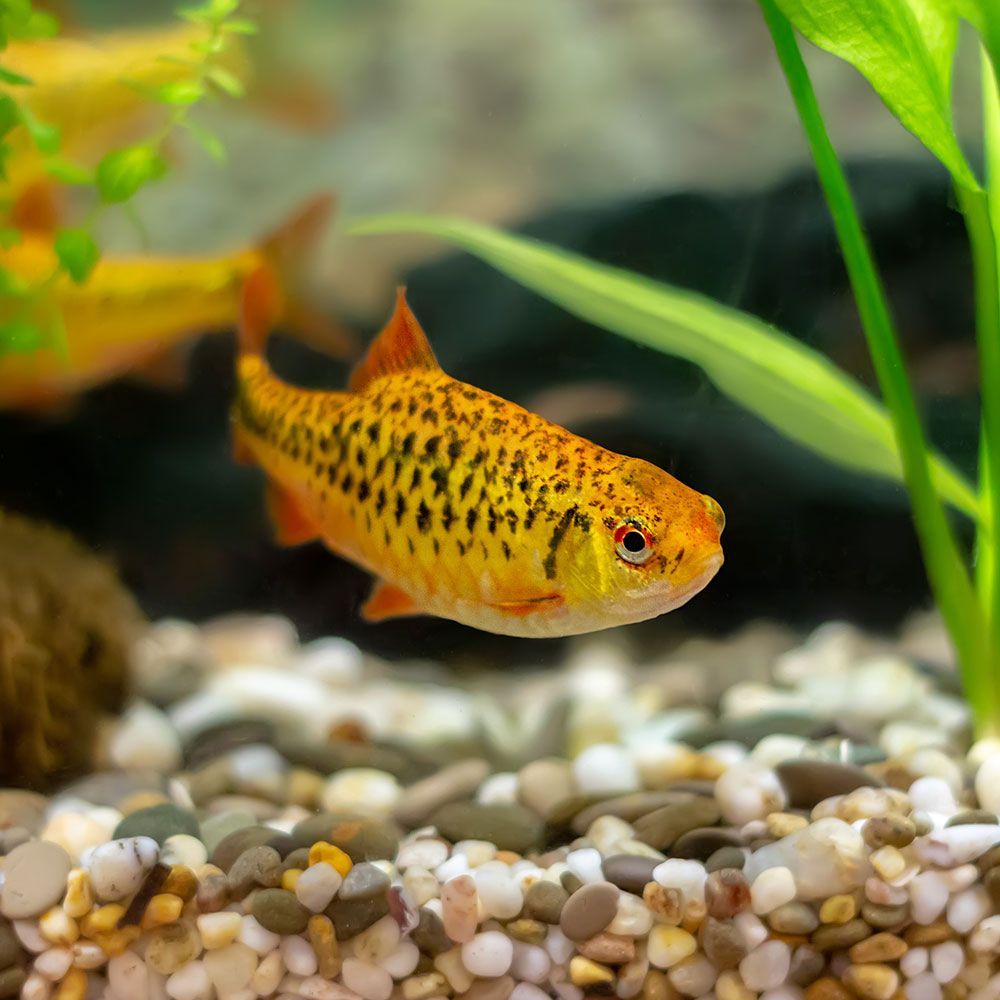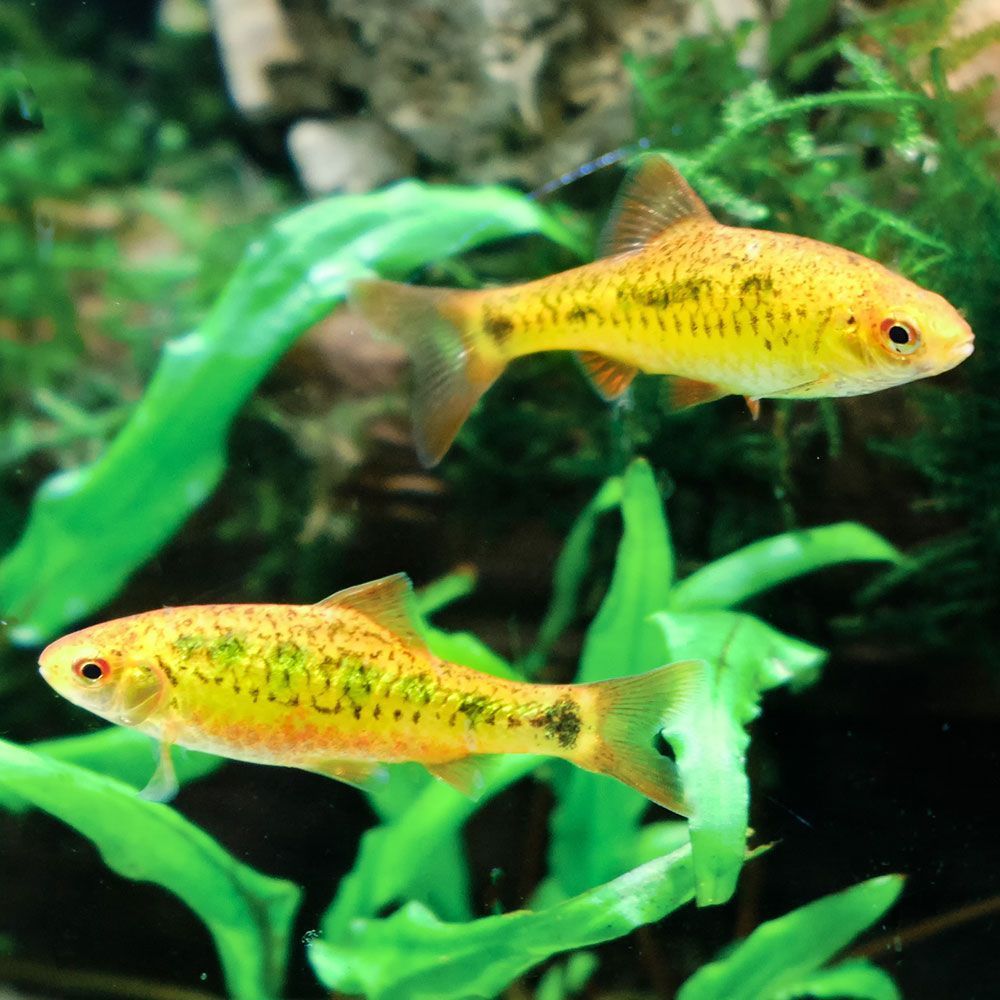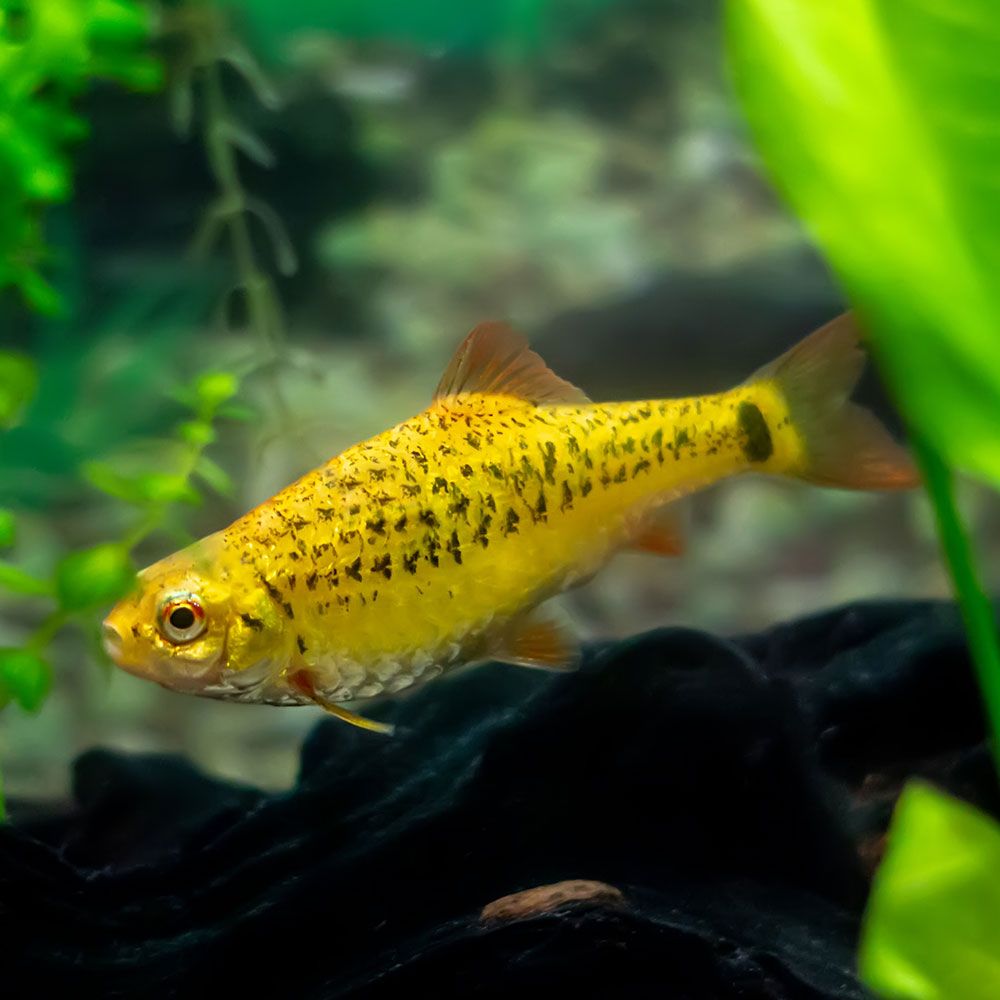If you’re looking for a beautiful freshwater fish for your peaceful community tank, the gold barb can be the perfect addition!
It is a no-fuss species that will eat just about anything you can offer and demands no special tank decoration requirements.
So, if you are curious to know more about this darling, keep reading!
What is a Gold Barb?
Gold Bard is a freshwater fish that requires very low maintenance and keeps calm in the aquarium.
| Origin | Vietnam, Red river basin in southwestern China, northern Laos, Taiwan |
| Order | Cypriniformes |
| Family | Cyprinidae |
| Scientific Name | Barbodes semifasciolatus |
| Common Names | Gold barb, Chinese barb, half-banded barb, green barb, half-stripes barb, Chinese half-striped barb, Schubert’s barb, six-banded barb, China barb, gold finned barb, Barbel. |
| IUCN Red List Status | Least Concern |
| Appearance | golden yellow color with black vertical stripes that run across its body |
| Size | Usually up to 3.5 cm (1.4 in), Maximum: up to 7-8 cm (approx. 3 in) |
| Lifespan | 4-6 years, with great care 7 years |
| Temperament | Peaceful |
| Tank Level | Mid to bottom-dwelling |
| Water Temperature | 64-75 °F (18-24 °C) |
| pH Level | 6-8 |
| Water Hardness | Up to 10 dGH |
| Care Level | Easy |
| Minimum Tank Size | 30 gallons for 5 members |
| Tank Environment | Spacious, well-lit, fine-grain substrate with live plants, rocks, and caves |
| Diet | Omnivorous, has scavenger tendencies |
| Tank Mates | Own group, other peaceful species of similar size |
What is the Natural Habitat of Gold Barb?
This gold barb fish is native to Vietnam, the Red River basin in southwestern China, northern Laos, and Taiwan.
However, in Taiwan, the fish is at risk due to loss or degradation of habitat.
It has also been found in Russia, but it is unknown if the Russian population is naturally occurring or not.
This barb likes to stay in slow-flowing and standing water bodies such as swamps and irrigation channels.
Due to accidental introduction through the aquarium trade, it is found worldwide now, including in the USA. It turned into a feral and invasive species in Hawaii and Singapore.
According to The IUCN Red List Status of Threatened Species assessment of 2011, this fish was marked Least Concern.
Which Family does Gold Barb belong?
This fish belongs to the Cyprinidae family under the Cypriniformes order and is scientifically known as Barbodes semifasciolatus.
However, the species is popularly known by many names like Chinese barb, gold barb, half-banded barb, green barb, half-stripes barb, Chinese half-striped barb, Schubert’s barb, six-banded banded barb, China barb, gold-finned barb, and Barbel.
Fun Fact: Gold barb is pretty much similar to Barbodes snyderi. But the former is leaner with 4-5 vertical marks. While the latter has only tiny barbels with 7-9 dark vertical marks.
How does Gold Barb look?

Now, if you want to know how you can recognize this fish, let us tell you the details here!
What is the Size of Gold Barb?
Commonly, the adult gold barb grows up to 3.5 cm (1.4 in). However, the largest size that this fish has reportedly grown to is 7-8 cm (2.8-3.2 in).
What is the Color of Gold Barb?
This gold barb is originally green in color in the wild. But in the aquarium trade, you will find this fish having a golden yellow color with 4-5 black vertical marks that run across its body.
This difference in color from the wild strain is due to selective breeding by an American hobbyist Thomas Schubert in the 1960s.
The juveniles have 3-5 dots on the mid-lateral scale row which becomes larger and fuses with the ones at the fin bases to form the dotted stripes. Its back is reddish brown, and the sides can also look brassy or yellow-green.
The fish fins are almost translucent. But some strains have reddish fins.
The fish has some other color variants like albino, pink, and tricolor varieties which are black, yellow, and pink. Among all, the gold strain is the most popular.
Note: Captive selective bred gold barbs were assumed to be a different species and even given a separate binomial name: Puntius semifasciolatus var. Schuberti. But later, it was found that the wild and captive ones were the same species.
What are the Features of Gold Barb?
The gold barb is highly recognizable because of its steeply sloped back. The fish’s mouth is tilted backward and has two short barbels at the corner of the mouth.
Its last simple dorsal fin is serrated posteriorly.
The species has big eyes on each side of its head and smooth thin lips. The groove behind its lips is interrupted medially.
Its body has lateral scale rows and 12-15 gill rakers on the first-gill arch.
What is the difference between a Male and a Female Gold Barb?
Usually, the male has a more streamlined shape and is smaller in size. The belly of the male turns red to red-orange when it is ready to spawn.
Females have duller colorations with rounded bellies and are usually larger than males.
How do Gold Barb Behave in the Aquarium?
The gold barb fish is peaceful, and it gets on well with other fish who share its temperament. It likes to stay in schools of its kind. In fact, larger groups make the fish happier and healthier.
Further, its behavior becomes interesting when two rival male gold barbs compete for a female’s attention or a higher position in the hierarchy.
When stressed, this fish may nip fins and destroy aquarium plants.
What is the Lifespan of Gold Barb?
The average lifespan of this species is 4-6 years; however, in my experience, it can live up to 7 years with the best care.
Author’s Note: The gold barb reaches reproductive maturity at 10-11 months, and the females sexually mature earlier than the males.
How to take care of Gold Barb?

If you want to bring this little fish home, you have to make it happy with a proper home. Let us tell you how to do that.
What is the Tank Size of a Gold Barb tank?
Since this fish likes to school with its own kind, you have to keep 5 of them together. For this, you need a 30-gallon tank.
It is very active in schools, so you can go for a larger tank as well. If you add members to the school or add other tank mates, increase the tank size accordingly.
What type of Water Chemistry is required in the tank for Gold Barb?
Gold barbs are sturdy fish, but only if you maintain the right water conditions, i.e.,
- pH Levels: 6-8
- Water Temperature: 64-75 °F (18-24 °C)
- Water Hardness: Up to 10 dGH
- Ammonia: 0 ppm
- Nitrite: 0 ppm
- Nitrate: Below 20 ppm
What should be the Tank Environment for Gold Barb?
The home of your fish should mimic its natural environment to keep it stress-free. So let’s get into the details here.
Does Gold Barb need Substrate?
Use a few layers of fine-grain soft and sieved sand as the substrateto keep your gold barb comfortable. This is important to protect your fish as it often tries to dig into the bottom. A darker substrate will bring out the shiny color of this species.
Which Plants are required for Gold Barb?
Gold barb needs lots of live plants to feel at home. But plan it appropriately so that there’s enough space in the middle of the tank for it to swim around.
According to some, it’s not wise to keep this species in a planted aquarium. This is because they uproot plants when stressed.
But don’t prevent your barbs from playing around in bushes. Instead, you must invest in strong-stemmed and strong-rooted plants. Some recommendations are java ferns, cryptocoryne, anubias, and hornworts.
What Lighting is required for Gold Barb?
Gold barbs require daylight, so standard tank lighting should be enough. However, requirements change during breeding because this species prefers dim lighting when spawning.
What Décor is required for Gold Barb?
You can add rock caves, driftwood, stones, snags, and other ornaments to decorate this tank. All of these provide suitable hiding spots for the fish.
Make sure you keep the tank lid tightly on at all times. This is a jumper fish and might make a fatal jump when agitated.
What is the Filtration required for Gold Barb?
A soft sponge filter should be used to get rid of impurities and keep water flow to a minimum. A hang-on back filtration system can also be used.
What should be the Water Flow Rate for Gold Barb?
This fish likes slow-flowing to almost standing water to swim around.
Fish Care Tip: To keep the water clean and unpolluted, keep changing 20% to 30% of the water volume each month.
What type of Food does Gold Barb eat?
Gold barb is a no-fuss eater and prefers an omnivorous diet. In the wild, it feasts on algae, diatoms, small insects, worms, crustaceans, organic detritus, and similar.
In the aquarium, it will also eat just about anything. Make sure you build a diverse diet plan for good health. You can try the following foods:
- Flake
- Pellet
- Freeze-dried food
- Frozen food
- Insects
- Brine shrimp
- Worms
- Bloodworms
- Daphnia
- Moina
- Shrimp pellets
- Mosquito larvae
- Grindal worms
- Algae wafers
Feed them once or twice daily and wipe off any remaining, uneaten food from the water.
What are the Tank Mates for Gold Barb?
Since the gold barb is a schooling fish, it loves to have tank mates of its own kind, so keep at least 5 of them together. If you can invest in a bigger tank, you can also keep 8-10 of them.
It will behave well in barb-themed setups and with other peaceful fish. Some potential tank mates can be:
- Small danios
- Cherry barbs
- Zebra loaches
- Corydoras catfish
- Dwarf gouramis
- Cardinal tetras
- Neon tetras
- Zebra danios
- Black tetras
- Boesemani rainbows
- Cardinal tetras
- Ember tetras
- Odessa barbs
- Bristlenose plecos
- Hoplo catfish
- Otocinclus catfish
Which Tank Mates to Avoid for Gold Barb?
There are also some species you must never house with a gold barb. Here’s a quick peek into that:
- Aggressive species: Barbs will be scared of them
- Slow-moving long-finned species: Barbs can display fin-nipping behavior.
- Smaller species: These may become prey for your barb
Some fish that are not compatible with gold barbs are:
- Tiger barb
- Goldfishes
- Angelfishes
- Bettas
- Cherry shrimp
What are the Common Diseases associated with Gold Barb?
Gold barb is robust and not prone to any diseases. But look out for the signs of these freshwater fish diseases that might inflict on your pet.
| Disease Name | Causes | Symptoms | Treatment |
|---|---|---|---|
| Freshwater Ich | Parasitic infection | White spots on the skin, withdrawn attitude, loss of appetite, not schooling, and rapid breathing | Add aquarium salt and copper sulfate, elevate water temperature |
| Fin rot | Bacterial Infection, poor water quality, and contact with sick fish | Loss of color, ripping fins, loss of appetite, and lethargy | Aquarium salt and antibiotics, enhance water quality, remove physically injurious decor |
| Columnaris | Bacterial Infection | White or grey patches, lethargy, loss of appetite | Water quality enhancement, antibiotics, stress reduction |
| Dropsy | Infection, body fluid build-up, stress, poor water quality | Bloated stomach, swimming at the bottom, going into hiding, lethargy, and loss of appetite | Salt baths and medication |
| Swim Bladder Disease | Bacterial infection | Struggling to remain stable, lying on its side | Feed daphnia and shelled peas, antibiotics treatment |
Quick Tip: Don’t expose the fish to high temperatures around 82 °F (28 °C) for too long.
How to Breed Gold Barb?
Gold barb is quite easily bred, but a proper setup will further increase your chances. So, keep reading to know it all.
How to Obtain the Specimen and Condition Gold Barb?
Choose a plump female and a brightly colored male. These characteristics show that they are ready for spawning. You can also get a group of equal numbers of males and females, depending on your tank size.
Condition the pair before placing them in a breeding tank. Feed them nutritious food like brine shrimp for 2-3 days.
What is the Tank Preparation for Gold Barb?
Choose a tank size depending on the number of specimens you’ll work with. For one male and one female, 20 gallons is ideal. However, for 3 males and 3 females, choose a 40-gallon tank.
The breeding tank should be dimly lit and have a very soft water flow. Add a sponge filter or air stones to maintain a healthy environment and prevent the fry from getting sucked in.
Use plants like java moss to provide the female with a leafy cover. A mesh cover layer or marbles can be added to the bottom to allow the eggs to fall through.
Maintain the following water parameters:
- Water Temperature: 75 °F (24 °C)
- pH Levels: 6-7
- Water Hardness: 8 dGH
What is the Mating Process for Gold Barb?
This species spawns during dawn. The male circles around the female and nudges her to position her near the spot he has chosen for spawning. The female will release about 300 eggs which will be fertilized by the male.
Adults should be immediately separated from the eggs as this species feasts on them soon after fertilization.
What is the Incubation period for Gold Barb?
The pale yellow eggs hatch within 2-3 days of fertilization, and the fry becomes free swimming in about 24 hours.
The fry will feed on the yolk sac for the first few days. After a few days, you can move on to fine dry food, infusoria, and freshly hatched brine shrimp to meet their nutritional needs.
How to Maintain the Fry Tank for Gold Barb?
The fry tank should have dim light as these are sensitive to lighting until they are several weeks old.
How to Buy Gold Barb?
- Buy gold barb from a trusted breeder or pet store that has clean aquariums and no unhealthy fish in the tank. The fish is unhealthy if it has torn fins, white spots, or brown patches on the body.
- Make sure the barbs you choose are lively with clear, bright eyes.
A word from FishInAquarium
It’s a pretty sight to watch gold barbs swimming about in your aquarium like glimmering little flames. The sturdy little things are great for both beginners and experts. And they can keep you entertained for hours with their antiques.
So, if this think-piece has convinced you to give some love to this species, share it with other enthusiasts. Let them discover the wonders of this fish along with you.
And, if you have any questions on your journey with this fish, definitely drop an email, and we will sort things out in no time!


